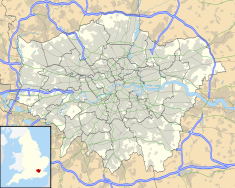Earl's Court is a district of Kensington in the Royal Borough of Kensington and Chelsea in West London, bordering the rail tracks of the West London line and District line that separate it from the ancient borough of Fulham to the west, the sub-districts of South Kensington to the east, Chelsea to the south and Kensington to the northeast. It lent its name to the now defunct eponymous pleasure grounds opened in 1887 followed by the pre–World War II Earls Court Exhibition Centre, as one of the country's largest indoor arenas and a popular concert venue, until its closure in 2014.

South Kensington is a district just west of Central London in the Royal Borough of Kensington and Chelsea. Historically it settled on part of the scattered Middlesex village of Brompton. Its name was supplanted with the advent of the railways in the late 19th century and the opening and naming of local tube stations. The area has many museums and cultural landmarks with a high number of visitors, such as the Natural History Museum, the Science Museum and the Victoria and Albert Museum. Adjacent affluent centres such as Knightsbridge, Chelsea and Kensington, have been considered as some of the most exclusive real estate in the world.
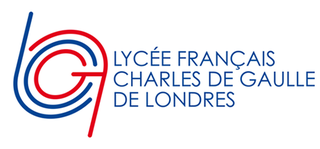
The Lycée Français Charles de Gaulle, usually referred to as the Lycée or the French Lycée, is a French co-educational primary and secondary independent day school, situated in South Kensington in the Royal Borough of Kensington and Chelsea, London. It is managed by the Agency for French Teaching Abroad, AEFE, with its curriculum accredited by the French National Ministry of Education and overseen by the French Ministry of Foreign Affairs.

Gloucester Road is a street in the Royal Borough of Kensington and Chelsea, London. It runs north–south between Kensington Gardens and Old Brompton Road.

Brompton, sometimes called Old Brompton, survives in name as a ward in the Royal Borough of Kensington and Chelsea in London. Until the latter half of the 19th century it was a scattered village made up mostly of market gardens in the county of Middlesex. It lay southeast of the village of Kensington, abutting the parish of St Margaret's, Westminster at the hamlet of Knightsbridge to the northeast, with Little Chelsea to the south. It was bisected by the Fulham Turnpike, the main road westward out of London to the ancient parish of Fulham and on to Putney and Surrey. It saw its first parish church, Holy Trinity Brompton, only in 1829. Today the village has been comprehensively eclipsed by segmentation due principally to railway development culminating in London Underground lines, and its imposition of station names, including Knightsbridge, South Kensington and Gloucester Road as the names of stops during accelerated urbanisation, but lacking any cogent reference to local history and usage or distinctions from neighbouring settlements.
Launceston, also known at some periods as Dunheved, was a parliamentary constituency in Cornwall which returned two Members of Parliament to the British House of Commons from 1295 until 1832, and one member from 1832 until 1918. It was a parliamentary borough until 1885, and a county constituency thereafter.
Thomas Cundy III was a British architect. He joined his father's practice in the 1840s and was also surveyor of the Grosvenor Estate, London. He retired from that post in 1890, and was succeeded by Eustace Balfour.

Onslow Square is a garden square in South Kensington, London, England.

St Stephen's Church, Gloucester Road, is a Grade II* listed Anglican church located on the corner of Gloucester Road and Southwell Gardens in South Kensington, London, England.

Pelham Crescent is a circa 1825 Georgian crescent of houses in South Kensington, London SW7, England, designed by architect George Basevi. Numbers 1–14 and 15–27 are separately Grade II* listed.

Cornwall Gardens is a long narrow garden square in South Kensington, London, England.

Victoria Grove is a street in Kensington, London W8. House building began in 1837 and was completed in 1841.

The Gloucester Arms is a Grade II listed pub at 34 Gloucester Road, Kensington, London SW7, built in the 19th century. It is owned by Greene King.

56–58 Queen's Gate Terrace is a pair of Grade II listed houses in Queen's Gate Terrace, Kensington, London SW7, built in 1863–65 by the architect Charles Gray.
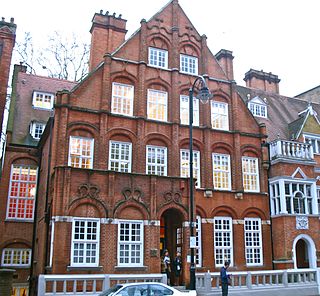
Harrington Gardens is a street which has a communal garden regionally sometimes known as a garden square in the Royal Borough of Kensington and Chelsea in London. The street runs from Collingham Gardens and Collingham Road in the east to Gloucester Road and Stanhope Gardens in the west. It is crossed by Ashburn Place and joined by Colbeck Mews on its north side. It contains several listed buildings including an important group of grade II* buildings on the south side numbered 35 to 45.
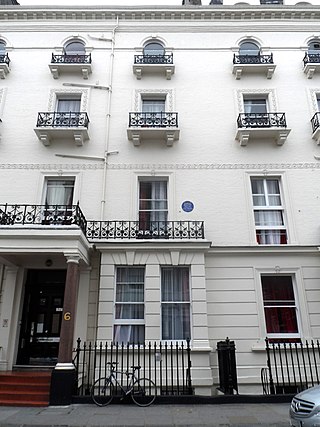
Grenville Place is a street in the Royal Borough of Kensington and Chelsea, London, that connects Cornwall Gardens and Launceston Place in the north with Cromwell Road in the south. It is crossed in its northern part by Cornwall Mews South, and joined on its western side by Emperor's Gate (twice). it is joined on its eastern side by Southwell Gardens.
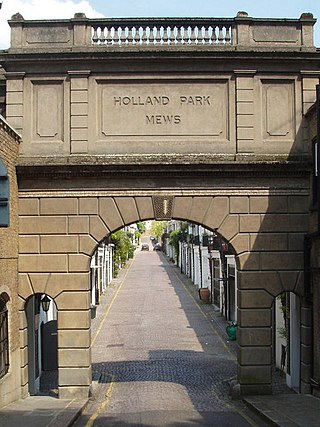
Holland Park Mews is a mews street in the Holland Park district of the Royal Borough of Kensington and Chelsea in London, W11. The mews consists of 67 residential properties, originally built as 68 stables, on a cobbled road with two entrances from Holland Park. The west entrance passes under an arch listed Grade II on the National Heritage List for England. The arch was built in 1862, and the stables from 1860 to 1879.

Kensington New Town is an area of housing in Kensington, London, which was developed in the early 19th century. It lies to the south of Kensington High Street and to the southwest of Kensington Gardens.

Hesper Mews is a mews street in the Earl's Court district of London, England. It runs between Bramham Gardens and Collingham Gardens and was laid-out in 1884-85 as part of the Gunter Estate, developed in the nineteenth century by James Gunter and his descendants.

Sussex Square is a garden square in Paddington in Central London. Located in the City of Westminster, it is part of the Tyburnia area north of Hyde Park. Stanhope Terrace runs along its southern side.

